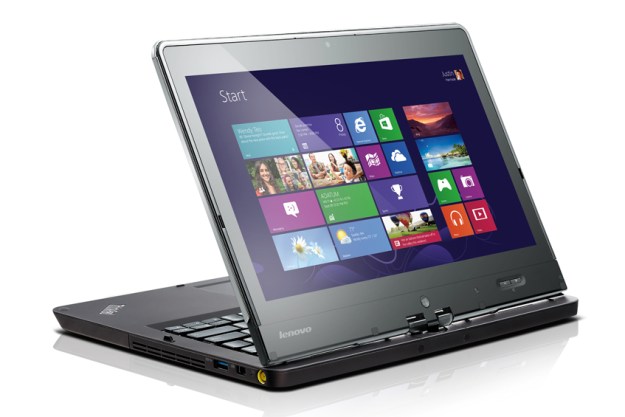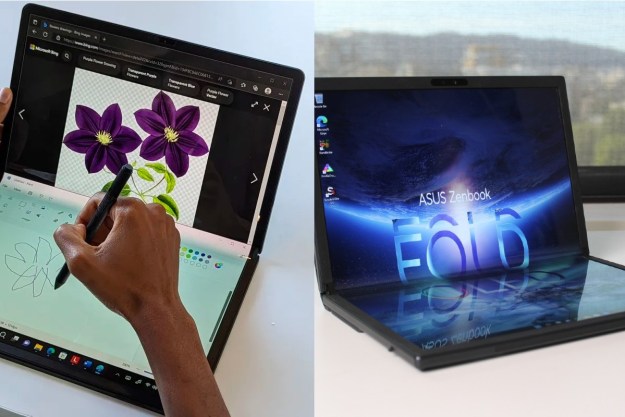
“We weren’t surprised to find that Lenovo’s new convertible is a good laptop. The company’s experience in this area has paid off with Microsoft’s move towards touchscreen devices. No other convertible on the market can match the value proposition of the Twist.”
- Good build quality
- Thin and light
- Excellent keyboard
- Great hardware value
- Limited connectivity
- Extremely dim display backlight
- Runs hot when displaying 3D graphics
- Confusing bloatware
The release of Windows 8 has forced laptop manufacturers to re-think their approach to the device. Companies have been challenged to come up with new ideas for convertibles they have no experience producing. Lenovo, however, has been in this business for about a decade. They just need to introduce a new twist (pun intended) on what they’ve already accomplished.
Joking aside, Lenovo’s ThinkPad Edge Twist is an old bag for the company’s engineers. The ThinkPad X-Series convertible, which is of roughly the same size, is generally considered the benchmark other convertibles must live up to. The new model is a tweak to a product the company has been producing for years.
Our review unit arrived with a Core i5-3317U processor and 4GB of RAM. This represents a mid-range model, which, at the time of this writing, is priced just over $800. The Twist seems a great value at first glance, but let’s see what else Lenovo has done to make the Twist a convertible for the masses.
Not an Edge at first glance
We got our first hands-on time with the Twist at a retail store several days before the unit arrived. It wasn’t clearly advertised as part of the Edge product line, and nothing we saw made us think it was. This is a sturdy and conservative laptop finished in traditional matte black, which is boring yet functional. If you think other ThinkPads are ugly, you’ll think the same of this.

Close examination reveals why the Twist is part of the Edge product line. Minor chassis flex appears during rough handling, the hinge mechanism is made of plastic, and there are no drain holes to protect the laptop from spilled coffee. These features are missed, but their absence is the secret sauce behind the laptop’s low price.
Flex aside, build quality is solid. Panel gaps are few, and the rugged matte plastic feels as sturdy as ever. There are laptops made almost entirely out of aluminum that feel less rigid.
Though it’s a solid machine, connectivity is an issue. There are only two USB ports available (both 3.0, thankfully), and video output comes from mini-HDMI or mini-DisplayPort. Besides those, the only other ports include a card reader and a combo headphone/microphone jack.
A legendary interface
This laptop’s convertible nature comes from its swivel-hinge design that lets the display rotate 180 degrees and then close over the keyboard. Lenovo has used this concept for years because it works without adding significant weight or bulk.
Touching the screen is a premium experience in both tablet and laptop mode. Despite the Twist’s cost-conscious nature, Lenovo has managed to afford a Gorilla Glass screen that feels upscale and is extremely responsive. It’s nothing unique, but it does what it’s meant to.
Lenovo hasn’t sacrificed the keyboard to the touchscreen. The laptop offers the standard AccuType keyboard featuring excellent key travel and large key caps. It’s one of the best keyboards currently available on any laptop, and it’s a huge improvement over the average for laptops of this size. Backlighting is strangely absent, which can make use in dark environments more difficult.
Below the keyboard is a small but adequate touchpad. It could be larger, but it’s responsive and handles tap-to-click well. It’s supported by a classic trackpointer that, as always, is a boon for touch-typists. It lets users move the mouse cursor without lifting a hand away from a typing position.
A handicapped display
Lenovo ships the Twist with a 1366 x 768 IPS display. That’s impressive hardware for an $800 laptop and it scored well in benchmarks. Our tests showed it capable of rendering 70 percent of the sRGB gamut and black levels were extremely deep.
All of this is hardly matters, however, because the display isn’t bright enough. Matters are made worse by the glossy Gorilla Glass finish. Together these traits make using the laptop a chore in even a moderately lit room. Image quality doesn’t matter if glare obscures what’s being viewed.

We’re particularly sad to see this problem because we’ve previously reviewed a Lenovo X-Series with a matte IPS display of similar resolution and quality. We thought it looked great. But the matte finish isn’t available on the Twist, even as an added-cost option.
The Twist’s audio quality is typical of a small modern laptop: reasonably loud but sounds tinny due to a lack of meaningful bass. Most users will want to use the laptop with a pair of external speakers or headphones.
Too quiet?
Sound testing showed the Twist to be an impressively quiet system. At idle it didn’t register above ambient noise, and it only pegged at 44.1 decibels at full load, which is an extremely low result. In most situations this laptop can only barely be heard.
At idle, the modest fan managed to keep temperatures extremely cool at around 80 degrees Fahrenheit. Loading the CPU raised that number to a still-tolerable maximum of 93.1 degrees. When stressing the integrated graphics processor (IGP), however, the fan was outmatched. It allowed temperatures on the right-hand bottom of the laptop to reach as blistering 119.4 degrees. That’s hot enough to make the laptop extremely uncomfortable when playing a game.
Easy traveler
Packing the Twist for a trip isn’t difficult. It weighs in at just 3.5 pounds and is about 0.8 inches thick, which is just enough to earn it the title of Ultrabook. This laptop is small enough to carry in almost any bag.
Pairing a small package with a keyboard and a swivel hinge forced Lenovo to use a modest 42Wh battery. Despite this, the laptop did well in our battery benchmarks, lasting 1 hour and 55 minutes in our heavy-load Battery Eater test, 5 hours and 10 minutes in our Web browsing test, and 6 hours 51 minutes in our light-load test. These scores are about average for an Ultrabook.
Low power draw is no doubt the reason for respectable endurance. We noticed the Twist consumed as little as 8 watts at idle with the display at 50 percent brightness. A full CPU load at the same brightness increased consumption to just 22 watts. These results are the best we’ve ever recorded from an Ultrabook.
A little bloat, a little confusion
A variety of pre-installed software, like Amazon’s Kindle Reader, AccuWeather, and Norton Security are lumped together in a “Lenovo Apps” section of the start screen. We were glad to see that the company doesn’t double-dip on bloat by placing the same apps on the desktop.
We’re dismayed to report that Lenovo doesn’t ship this laptop with the useful power management and connectivity software found in previous products. This software has been replaced with a confusing mash of options that don’t work well.
The new custom Start menu replacement is a prime example of the ill-working software: it’s a fine idea, but the final product has a razor-thin scroll bar and doesn’t respond at all to multi-touch scrolling via the touchpad. Instead, it only responds to scrolling via the touchscreen.
Perfectly adequate performance
Considering the price and features, we weren’t surprised to find the Twist packing mundane internal hardware. Its Core i5-3317U processor is the standard among Ultrabooks, and it returned typical scores. SiSoft Sandra’s Processor Arithmetic benchmark reached 35.15 GOPS while 7-Zip turned in a combined score of 6,990 MIPS. Both are average.
PCMark 07 turned in a score of 3,489, which, though it isn’t a stellar result, it’s respectable and particularly good for a small laptop sold below $1,000. The system’s quick solid-state drive provides strong scores across the board and, when paired with the Core i5 processor, a snappy user experience.
The only weakness is 3D performance. 3DMark 06 and 3DMark 11 returned respective scores of 4,069 and 568. Both these scores are typical for a laptop with this processor and indicate a system that can handle modern games only at low to medium detail. These scores, combined with the high temperatures recorded while stressing the IGP, make the Twist a poor choice for gamers.
Conclusion
We weren’t surprised to find that Lenovo’s new convertible is a good laptop. The company’s experience in this area has paid off with Microsoft’s move towards touchscreen devices. No other convertible on the market can match the value proposition of the Twist.
The Twist is a great laptop, even when the convertible hinge is taken out of the equation. Battery life is robust, the keyboard is excellent, and build quality is good. Most small laptops fail in at least one of these areas.
It’s shame that these benefits are soured by the display. Though technically capable of excellent image quality, the glossy finish and dim backlight make for frustrating use. If Lenovo added a matte display, it would’ve instantly added a point to our review score. Until then, the Twist will remain a promising laptop we wish we could recommend.
Highs
- Good build quality
- Thin and light
- Excellent keyboard
- Great hardware value
Lows
- Limited connectivity
- Extremely dim display backlight
- Runs hot when displaying 3D graphics
- Confusing bloatware
Editors' Recommendations
- Lenovo ThinkPad deals: Save over $1,000 on the classic laptop
- The best Lenovo laptops for 2023: ThinkPad, Yoga, and more
- Why the Dell XPS 13 Plus still beats the latest competition in little laptops
- Why the latest ThinkPad X1 Yoga Gen 8 isn’t worth the upgrade
- Lenovo’s latest ThinkPad Z13 includes a lid made entirely of flaxseeds










